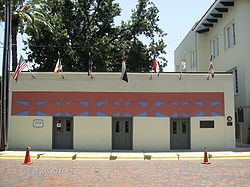- Republic of the Rio Grande
-
Republic of the Rio Grande
República del Río GrandeUnrecognized state ← 
←
←
1840  →
→
 →
→
 →
→
 →
→

Flag Seal Capital Laredo¹ Language(s) Spanish Government Republic President Jesús de Cárdenas History - Siete Leyes January 17, 1840 - Camargo War November 6, 1840 Area 300,000 km2 (115,831 sq mi) Currency Peso Today part of  Mexico
Mexico
 United States
United States¹ Later moved to Guerrero, Tamaulipas, and in March 1840 to Victoria, Texas until disestablishment. The Republic of the Rio Grande was an independent nation that insurgents against the Central Mexican Government sought to establish in northern Mexico. The rebellion lasted from January 17 to November 6, 1840 and the Republic of the Rio Grande was never officially recognized.
Contents
Background
After a decade of strife, Mexico won its independence from the Kingdom of Spain in 1821. After a failed attempt at a monarchy, Mexico adopted a new constitution, the 1824 Constitution. This new constitution established los Estados Unidos Mexicanos, or "the United Mexican States," as a federal republic, similar to the United States.
In 1833, General Antonio López de Santa Anna was elected to his first term as president and was, at the time of his election, in support of the federal republic. However, after some members of government angered Santa Anna's political allies, Santa Anna decided to start a centralized government.[1] Santa Anna suspended the constitution, disbanded Congress and made himself the center of power in Mexico. This led to the eruption of a number of uprisings and secessionist movements throughout the country, the most successful being the Texas Revolution. Less successful secession movements were attempted by the Republic of Zacatecas and the Republic of Yucatán. At the same time there was activity inside the country of fillibusters, which sought to expand slavery in Mexico. Many of the caudillos that initiated and participated in the rebellion also participated in later violent secessionist movements.
Rebellion
On January 17, 1840 a meeting was held at the Oreveña Ranch near Laredo.[2] A group of notables from the states of Coahuila, Nuevo León, and Tamaulipas advocated a rebellion seeking secession from Mexico and formation of their own federal republic with Laredo as the capital. However, those states' own congresses and governments never took any action to support the insurgents, and requested the help of the Central government in Mexico City to aid the local state armies.[3]
The insurgents designated their own officials. They were:
- Jesús de Cárdenas, president.
- Antonio Canales, commander-in-chief of the army.
- Juan Nepomuceno Molano, council representative for Tamaulipas.
- Francisco Vidaurri y Villaseñor, council representative for Coahuila.
- Manuel María de Llano, council representative for Nuevo León.
- José María Jesús Carbajal, council secretary.
After the meeting, the insurgents temporarily moved to Guerrero, Tamaulipas, for security reasons. After the Battle of Morales in March 1840, the government moved to Victoria inside the Republic of Texas, where it remained until the rebellion collapsed later that year.
Insurgent operations
The respective armies of the insurgents General Antonio Canales and Mexican General Mariano Arista met at Morales, Coahuila, on March 24 and 25 1840. The Centralist Mexican forces defeated the insurgent forces. Included in this defeat was the trial and execution of 23 members of the insurgents' cavalry, including Colonel Jose Antonio de Zapata, the commander of the cavalry, on March 29.[4] General Canales and the remaining insurgents that survived the Battle of Morales sought refuge in San Antonio, Texas.
General Antonio Canales Rosillo traveled throughout Texas to build awareness of the rebellion for which he now fought. He also toured Texas to ask Texans to volunteer to fight his cause.[5]
General Canales was in Austin the second half of April 1840, where he met with President Mirabeau B. Lamar.[6] It is said that President Lamar privately supported the new republic’s actions, but felt that public endorsement would hamper Texas’ efforts to secure recognition of its own independence from Mexico. General Canales left Austin for Houston on May 2 to continue to build awareness and seek volunteers.
While official recognition from the Republic of Texas was not obtained, General Canales' tour was met with some success. On June 1, he arrived in San Patricio, where the rebellion forces had been reorganizing. In addition to 300 volunteers, the army had grown to include 140 Texan and 80 Native American volunteers. The Texan volunteers were led by Colonel Samuel W. Jordan.[7]
General Canales sent Colonel Jordan and approximately 90 Texan volunteers south into disputed territory in late June; they crossed the Rio Grande, and took Ciudad Victoria, the capital of Tamaulipas, without any resistance. A few of those who were guiding Colonel Jordan were still loyal to the Centralist government of Mexico and were trying to lead the Texans towards San Luis Potosí, where a Mexican ambush awaited. Colonel Jordan suspected such and diverted his troops to Saltillo, Coahuila, where, on October 25, he was attacked by Mexican General Ráfael Vásquez. Despite the fact that part of his troops deserted, Colonel Jordan was still able to defend himself and return to Texas.[8]
A failed rebellion
In November, representatives of Generals Canales and Arista met to discuss the war. During this meeting, the Mexican government offered General Canales the position of brigadier general in the Mexican army in exchange for his abandoning the cause of the rebellion. General Canales accepted the offer on November 6. Upon this event, the Republic of the Rio Grande rebellion failed.
Flag of the republic
The republic as a tourist attraction
Remnants of the republic's effect can be seen in:
- Zapata County, Texas, as well as the city of Zapata are named in honor of Republic of the Rio Grande cavalry commander, Colonel Jose Antonio de Zapata.
- Republic of the Rio Grande Capitol Building Museum is located in Laredo, Texas.
- In addition to the six flags, the Laredo Morning Times newspaper adds a seventh flag to its banner: the flag for the Republic of the Rio Grande.
See also
- Mexican Constitution of 1824
- Republic of Yucatán
- Filibuster (military)
References
- ^ Wilfred H. Callcott, "SANTA ANNA, ANTONIO LOPEZ DE," Handbook of Texas Online [1], accessed September 23, 2011. Published by the Texas State Historical Association.
- ^ The text of the constitution is available in Dippel, Horst, ed., Constitutions of the world from the late 18th century to the middle of the 19th century America Vol. 1. Constitutional documents of the United States of America Pt. 6. Rio Grande – Texas, München Saur 2008, ISBN 978-3-598-35756-5, pp. 9–13, “Ley orgánica de la República del Río Grande (1840)”
- ^ David M. Vigness, "REPUBLIC OF THE RIO GRANDE," Handbook of Texas Online [2], accessed September 23, 2011. Published by the Texas State Historical Association.
- ^ Roberto Mario Salmón, "ZAPATA, ANTONIO," Handbook of Texas Online [3], accessed September 23, 2011. Published by the Texas State Historical Association.
- ^ Roberto Mario Salmón, "CANALES ROSILLO, ANTONIO," Handbook of Texas Online [4], accessed September 23, 2011. Published by the Texas State Historical Association.
- ^ Herbert Gambrell, "LAMAR, MIRABEAU BUONAPARTE," Handbook of Texas Online [5], accessed September 23, 2011. Published by the Texas State Historical Association.
- ^ "JORDAN, SAMUEL W.," Handbook of Texas Online [6], accessed September 23, 2011. Published by the Texas State Historical Association.
- ^ [7] The Republic of the Rio Grande Museum web site
Citations
- Antonio Canales Rosillo from the Handbook of Texas Online
- The Laredo Morning Times Online edition
- “Mexico – Filibustering: Republic of the Rio Grande,” Flags of the World.
- Republic of the Rio Grande from the Handbook of Texas Online
- The Republic of the Rio Grande Museum web site
- “The Republic of the Rio Grande: A Story of Its Rise and Fall,” Sons of DeWitt Colony Texas.
- Antonio López de Santa Anna from the Handbook of Texas Online
- Yahoo! News article mentioning Republic of the Rio Grande in a present-day context
Categories:- Former republics
- Former countries in North America
- Former unrecognized countries
- States and territories established in 1840
- States and territories disestablished in 1840
- 1840 disestablishments
- 1840 in Mexico
- History of Laredo, Texas
- Mexican Texas
- History of Nuevo León
- Independent Mexico
- Former political entities in North America
Wikimedia Foundation. 2010.




